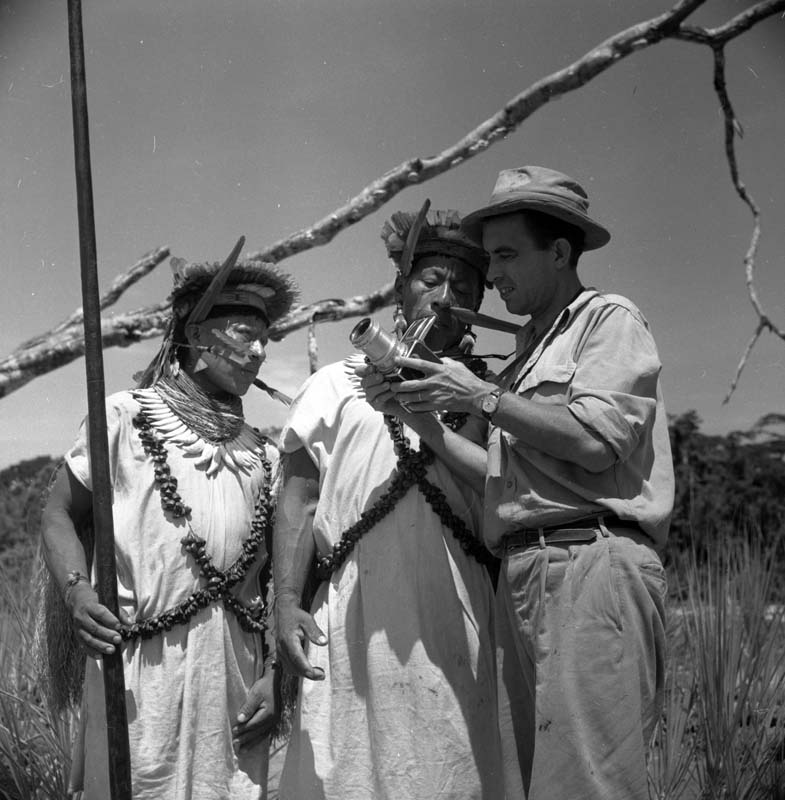
The explorer
Share
As a traveler, Rolf Blomberg was tireless. He was a man who wanted to discover, gain experiences and new knowledge. His life was marked by contact with indigenous peoples, animals and other realities completely alien to those of his native Sweden.
His first major experience was a trip to the Arctic Circle with a group of the Swedish Navy. He spent his life traveling to the most remote places, such as the jungles of Panama, Kenya, Senegal, Tanzania, South Africa or the Bolivian and Peruvian Amazon. He was, as he called himself: a real globetrotter.
In 1955 he became a member of the famous Explorers Club in New York, a place where the most famous travelers of the first half of the twentieth century met and gave lectures. Blomberg belongs to the saga of Scandinavian explorers who have performed real feats in unknown lands since the end of the nineteenth century.
His encounter with Ecuador began in 1934, when Blomberg was a young man of only twenty-two years old. Around this time, he made his first trip to the Galápagos Islands, where he stayed for eight months. An adventure in wild areas and without the slightest comfort. There he not only lived with turtles, sea lions and iguanas, but he also met the first settlers who had settled there, including a famous Baroness Wagner and her entourage of young lovers. The fascination that this trip aroused led him to follow his trail to Peru. This first chapter of his life in Ecuador ended with a trip along the Amazon, along the Orellana route.
Just two years after his first visit to Ecuador, he returned to the Galápagos for the second time. He then traveled to the eastern jungles where he sought contact with the Shuar Indians. He wrote a book about it "Camping among the Reductors of Heads" (1938) , a book that became very popular and has appeared in several languages.
Between 1938 and 1946 he began his adventures in the tropical forests of Southeast Asia, especially on Java and Borneo, but also visited Australia, the Philippines and Singapore. During this long journey, he had to endure the hardships of the Japanese invasion.
In 1947 he began the third chapter of his life and adventures in Ecuador. He will then have settled permanently in the country. During this period, his great expeditions took place over almost the entire Ecuadorian territory. Few places were foreign to him. He toured the eastern jungles and the then Emerald Jungle. There he met Volke Anderson, the Swedish owner of the famous Timbre hacienda and pioneer in the production and export of bananas.
He visited the Tsáchilas, a people that until then had only been studied by anthropologists Karsten and von Buchawald in the early twentieth century. This trip was made with a group of artists: Olga Fisch, Oswaldo Guayasamín, Lilian Robinson and Minie Bodenhorst.
His fascination with the primitive peoples of the jungle led him to seek contact with the Waorani, but the project was aborted due to the risks involved. His meeting with mountain lovers, the mountaineers Arturo Eichler, author of Snow and Jungle in Ecuador and Robinson, the famous Horacio López Uribe, also dates from this time. With them he managed to climb the Cotopaxi and the Iliniza's, among others.
He spent some time in Subida Alta, a village on the island of Puná, in the Gulf of Guayaquil. In this unique and isolated place of Ecuador, he spent long periods writing, meditating and thinking about new projects.
Blomberg made no less than six expeditions to the Llanganatis Mountains, where he searched for the famous Inca treasure of Atahualpa. According to legend, the treasure is said to be hidden at the bottom of one of the many lagoons.
